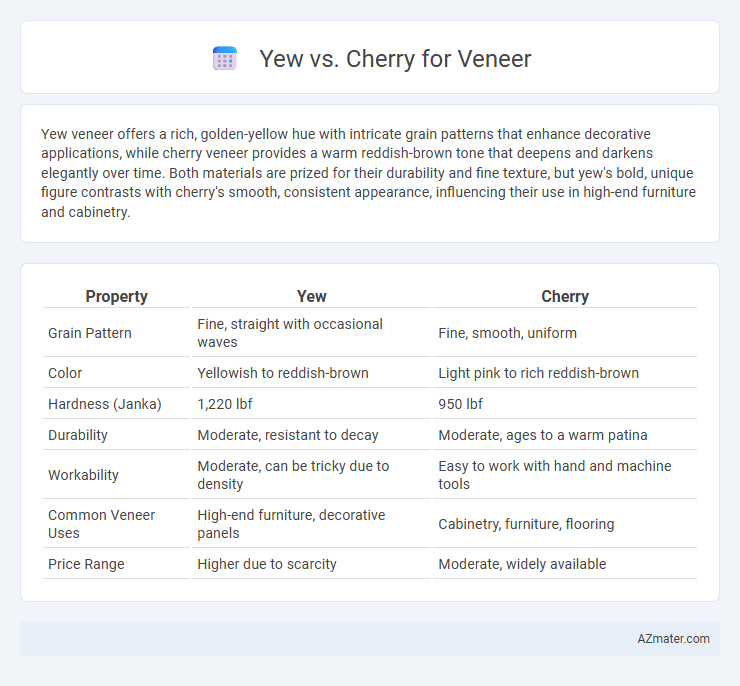Yew veneer offers a rich, golden-yellow hue with intricate grain patterns that enhance decorative applications, while cherry veneer provides a warm reddish-brown tone that deepens and darkens elegantly over time. Both materials are prized for their durability and fine texture, but yew's bold, unique figure contrasts with cherry's smooth, consistent appearance, influencing their use in high-end furniture and cabinetry.
Table of Comparison
| Property | Yew | Cherry |
|---|---|---|
| Grain Pattern | Fine, straight with occasional waves | Fine, smooth, uniform |
| Color | Yellowish to reddish-brown | Light pink to rich reddish-brown |
| Hardness (Janka) | 1,220 lbf | 950 lbf |
| Durability | Moderate, resistant to decay | Moderate, ages to a warm patina |
| Workability | Moderate, can be tricky due to density | Easy to work with hand and machine tools |
| Common Veneer Uses | High-end furniture, decorative panels | Cabinetry, furniture, flooring |
| Price Range | Higher due to scarcity | Moderate, widely available |
Overview: Yew vs Cherry for Veneer
Yew veneer is prized for its rich, warm hues and distinctive, irregular grain patterns that create a unique, natural aesthetic, making it ideal for luxury woodworking projects. Cherry veneer offers a smoother texture with a consistent reddish-brown color that darkens gracefully over time, favored for its classic elegance and versatility. Both veneers provide durability and fine finishes, but Yew stands out for its exotic appearance, while Cherry is preferred for timeless, refined interiors.
Botanical Background and Sources
Yew (Taxus baccata) and Cherry (Prunus avium) are prized for veneer production due to their distinct botanical characteristics and sources. Yew originates primarily from Europe and parts of Asia, characterized by dense, fine-grained wood with a rich reddish-brown hue, often used in high-end cabinetry and musical instruments. Cherry, native to North America and Europe, offers a smooth texture and warm reddish-pink color, harvested mainly from mature hardwood forests, making it a favorite for furniture and interior paneling.
Color and Grain Characteristics
Yew veneer features a rich, warm yellow to golden-brown color with occasional reddish hues, exhibiting a fine, straight grain that enhances its smooth, luxurious finish. Cherry veneer is known for its rich reddish-brown color that deepens over time, complemented by a fine, straight to wavy grain pattern that adds visual depth and elegance. Both woods offer distinct aesthetic appeal, with Yew providing a lighter, more delicate look and Cherry delivering a darker, more dramatic warmth ideal for high-end furniture and cabinetry.
Workability and Machining Performance
Yew veneer demonstrates excellent workability due to its fine, even texture and moderate hardness, allowing smooth cutting and shaping with minimal splintering. Cherry veneer offers superior machining performance, characterized by a uniform grain and consistent density that enables clean, precise cuts and efficient sanding. Both woods respond well to hand and machine tools, but cherry's slightly softer nature often results in faster machining and better edge definition.
Durability and Long-Term Performance
Yew veneer offers exceptional durability due to its dense grain structure, making it highly resistant to wear and decay over time compared to Cherry veneer. Cherry veneer, while aesthetically warm and rich in tone, tends to be softer and more prone to dents and scratches, which can affect its long-term performance in high-traffic applications. For projects demanding lasting strength and resilience, Yew is often preferred for its superior hardness and stability under varied environmental conditions.
Common Applications in Veneering
Yew veneer is prized for its distinctive grain patterns and warm, reddish-brown hues, making it ideal for decorative paneling, luxury furniture, and intricate inlay work. Cherry veneer offers a smooth texture with a consistent fine grain, commonly used in cabinetry, high-end architectural millwork, and classic furniture design. Both veneers excel in delivering aesthetic appeal and durability, but yew is often favored for rustic or traditional styles, while cherry suits contemporary and formal applications.
Environmental Impact and Sustainability
Yew veneer is known for its slow growth and limited availability, making it a less sustainable choice compared to cherry veneer, which comes from faster-growing trees with higher regeneration rates. Cherry wood extraction has a lower environmental footprint due to efficient cultivation practices and widespread availability, contributing to sustainable forestry management. Both woods require responsible sourcing to minimize deforestation, but cherry veneer generally offers a more eco-friendly option for sustainable interior design projects.
Cost Comparison of Yew and Cherry Veneer
Yew veneer typically costs less than cherry veneer due to its relative abundance and faster growth rate, making it a budget-friendly option for woodworking projects. Cherry veneer, prized for its rich color and fine grain, commands a higher price reflecting its premium quality and slower maturation. Comparing cost-per-square-foot, yew veneer often presents savings of 20-40% over cherry veneer, influencing material selection based on project budget constraints.
Finishing and Maintenance Needs
Yew veneer offers a smooth, fine grain that responds well to various finishes, providing a warm, golden hue and easy maintenance due to its natural resistance to moisture and insects. Cherry veneer develops a rich patina over time but requires more careful finishing with oil-based or lacquer coatings to protect its reddish tone and prevent surface wear. Both veneers benefit from regular dusting and avoidance of direct sunlight to maintain their appearance, with yew being slightly less demanding in ongoing care.
Choosing the Right Veneer: Yew or Cherry?
Yew veneer offers a distinct, rich grain pattern with a warm, reddish-brown hue, making it ideal for furniture requiring a dramatic, classic appeal. Cherry veneer provides a smoother texture and a consistent reddish tone that deepens elegantly over time, enhancing traditional and contemporary designs. Selecting the right veneer depends on the desired aesthetic: choose yew for bold, intricate grain, and cherry for subtle, uniform warmth.

Infographic: Yew vs Cherry for Veneer
 azmater.com
azmater.com